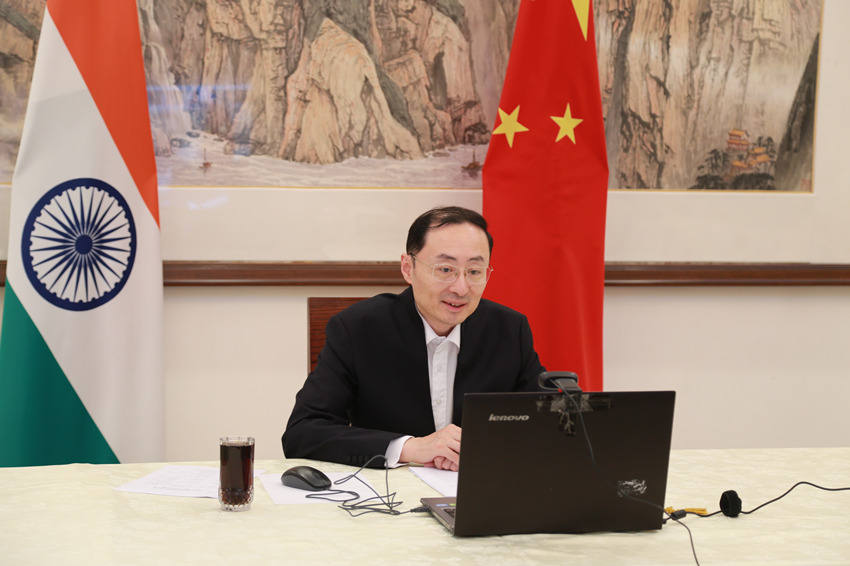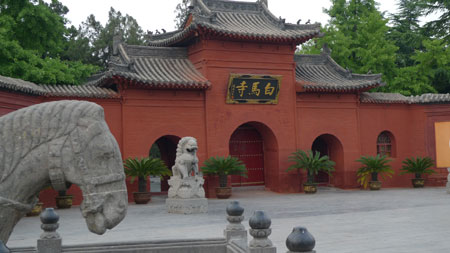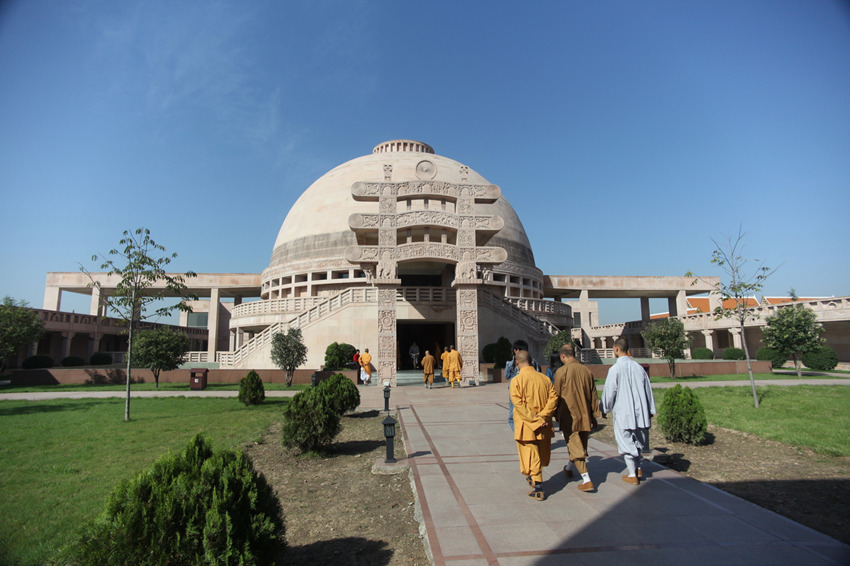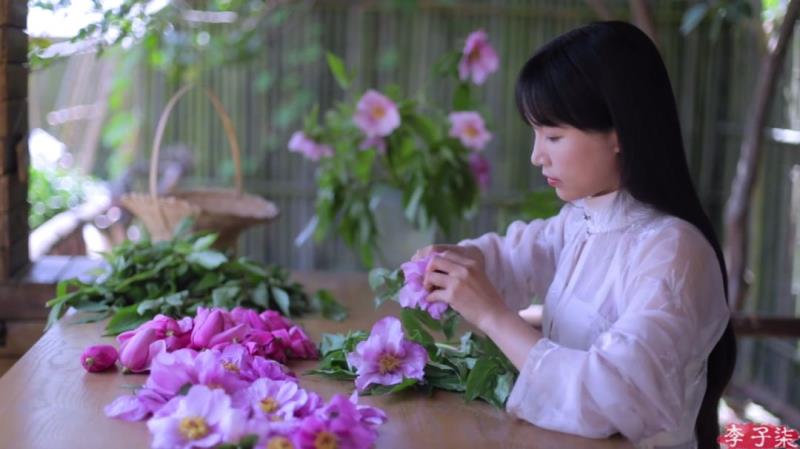|
(August 18, 2020)

Dear Indian sinologists, Chinese scholars, teachers and students,
Namaste!
I am very happy to meet you through online communication during this special period of COVID-19 pandemic. I also worked in education sector before joining foreign service and today I’m so glad to see a number of young faces here. Take this opportunity, I would like to share with you some thoughts.
First, friendly cooperation is the mainstream of bilateral relations in the long history of China-India exchanges. The exchange between China and India is like an age-old, heavy book worth reading for a lifetime. There is no second example in human history when we look back at the exchanges of our two great civilizations, which started more than 2000 years ago. China’s paper making, silk, porcelain and tea were introduced to India, while Indian singing and dancing, astronomy, architecture and spices were introduced to China. The exchanges and mutual learning between Chinese and Indian civilizations have made important contributions to the development of the two civilizations and the world at large.
One of the famous envoys of friendly exchanges between the peoples of China and India is Xuanzang, who was an eminent monk in Tang Dynasty. He came to India to study Buddhism 1300 years ago. After returning to China, he wrote the book Great Tang Records on the Western Regions, recording what he saw and heard during his 19-year journey. Among them, 17 special topics were mainly introduced to India, which became an important document for the study of ancient Indian history. I remember that it recorded a living habit of ancient Indians, which was to brush their teeth with Neem branches. I heard that people in some parts of India still brush their teeth with Neem branches. Science has proved that this kind of branches have antibacterial properties, and are even suitable for the prevention and treatment of oral ulcer. It shows how meticulous Xuanzang observed people’s lives at that time. Archaeologists from various countries also discovered many historical sites in India according to clues from the book, such as the Pillar of Ashoka at Sarnath, Nalanda temple and the Ajanta and Ellora Caves. These examples show the significance of exchange of human civilizations to the inheritance and development of ancient civilizations.
Second, China and India, as two ancient civilizations, should respect and learn from each other, treat each other as equals, and seek common ground while reserving differences. We cannot find two identical leaves in the world. Similarly, there are no two identical civilizations in the world. We should respect the diversity of the world and treat each other’s differences in a mature and rational manner. We need mutual respect and appreciation, be open and inclusive, so that we can trust each other and live in harmony.
Taking living habits for example, as a Chinese saying goes, “Do as the locals do”, which means, when you arrive at a new place, you should respect local traditions and customs. In India, people are used to eating by hands. It is because you could have the most authentic feeling of the food temperature and texture by hands. Some Indian friends told me that food not eaten by hands is not delicious. Of course, we should also pay attention to hygiene. Generally, when we have Indian food in a restaurant, the waiter will serve a small bowl of warm water with a slice of lemon in it. It’s not for you to drink, but to clean your hands. Chinese people are used to using chopsticks. A pair of chopsticks consisting of two wooden sticks embodies the extensive and profound Chinese food culture. If Indian friends learn to use chopsticks skillfully, you will win high praise from many Chinese friends. Whether it is eating by hands or by chopsticks, they are part of the living habits of our two nations that deserves respect.
Let’s move from living habits to cultural traditions. As another Chinese saying goes, “What's unique for a nation is of significance in the world.” which means, the more national characteristics it has, the more influential it becomes. Indian Bollywood movies, which enjoy worldwide popularity, are also very popular among Chinese audiences including me. I have watched movies like “Hindi Medium”, “Secret Superstar”, “Dangal”. The stories in these movies always resonate with me, leaving me touched. You may be aware that Indian movies are very popular in China and their box office revenue in China is twice of that in the Indian market. Yoga is another popular stuff which belongs to India. My wife is a yoga lover, who practices yoga at home every day. According to available statistics, more than 10 million people practice yoga to keep fit in China. I have also heard that there are hundreds of thousands of Indian friends practicing Chinese martial arts. Chinese acupuncture has been recognised as an independent medical system in India. This shows that our two countries have intensive cultural and artistic exchanges, delivering tangible benefits to our two peoples.
Furthermore, no matter which country you work and live in, you must respect local laws, regulations and customs to better integrate into the local life. We hope that Chinese citizens in India abide by local laws, regulations and customs, live in harmony with the local people and jointly promote friendly exchanges between the two countries.
More importantly, we need to respect our respective social systems. I believe that social system of every country is an independent choice made by its respective people, and no other country should interfere. China and India have different social systems and cultural traditions, but we all aim to embark on a development path that suits our own national conditions. The world is wonderful because of its differences. We need to understand each other, seek common ground while reserving differences, and work together to build a community with shared future for mankind. President Xi Jinping said that China will neither “import” foreign models of development, nor “export” the Chinese model and ask other countries to “copy” the Chinese practice. Indeed, we always look at the civilizations created by people worldwide with an open and broad mind, and conduct exchanges and cooperation with an attitude of mutual learning. As two rising major neighbors, China and India should abandon the old mindset of drawing lines by ideology, and get rid of the old game of “One's gain is another's loss” and “zero-sum game”. Otherwise, you would be led astray and go down a wrong path.
China and India should respect and support each other. The relationship between the states, just like the relationship between people, should be based on mutual respect with each other. As two neighbors and emerging major countries with a population of over 1 billion respectively, the growth of China-India relations will not only benefit our two countries and peoples, but also add stability and positive energy to peace and prosperity of the region and the world at large. Mutual respect and support between China and India is the right path and serves the long-term interests of both countries. Only by mutual respect and equal treatment can we continuously enhance mutual understanding and trust, avoid suspicion and misunderstanding, and realize the goal of “Dragon-Elephant Tango” between China and India on the road of peaceful coexistence and common development.
Third, since the establishment of diplomatic relations between China and India 70 years ago, bilateral relations have withstood tests and become more resilient. It should not be disturbed by one thing at a time. In this new century, bilateral relations should continue to move forward instead of backward. Not long ago, an unfortunate incident happened in the border areas that neither China nor India would like to see. Now we are working to handle it properly. It is a brief moment from the perspective of history. Chinese people often say that “Take a long-term perspective and look with a broadened horizon”, which means it is important to take a long-term perspective rather than only looking at the present. We need to see that friendly cooperation between China and India is the mainstream and the general trend. Only by seeing this can we maintain objective and rational judgment and correctly handle the differences between the two sides. I am convinced that China and India, two ancient civilizations, have the wisdom and ability to properly handle bilateral relations. We should have full confidence in the development of China-India relations.
What I want to emphasize here is that China’s basic foreign policy towards India remains unchanged. China sees India as a partner instead of a rival, and an opportunity instead of a threat. We hope to put the boundary question at an appropriate place in bilateral relations, properly handle differences through dialogue and consultation, and push bilateral relations back on track at an early date.
China’s foreign policy towards India has not changed for three reasons. The first one is that the basic national conditions of China and India as the two largest neighboring developing countries remain unchanged. China and India have been neighbors for generations that cannot be moved away. At the same time, we are also the two most populous developing countries in the world. Our top priority is to meet the needs of a total of 2.7 billion people and make sure that one third of the world’s population live a happy life. Therefore, both China and India need to concentrate on their own development and solve a number of problems such as rural revitalization, poverty eradication, education development, employment creation, and environmental protection. In this regard, we have a lot in common. This year, China will target to win the battle against poverty, eliminate absolute poverty, and build a moderately prosperous society in all respects. We are confident to achieve this task. In order to achieve such development goals, both of us need a peaceful and favorable external environment. Therefore, China and India, the two neighboring countries, should live in peace and avoid conflicts.
Second, the orientation of China and India as partners, friendly cooperation and common development remain unchanged. Over the past two years, the two leaders held two Informal Summits and reached a series of important consensus on the development of China-India relations, which has provided guidance to us. We should adhere to leaders’ consensus, particularly the basic judgment that China and India are each other's opportunities and pose no threat to each other. We should also transmit the leaders’ consensus to all levels and translate it into action. At present, facing the outbreak of COVID-19, we are supporting each other and working together to exchange experience in diagnosis and treatment as well as providing medical supplies, embodies the spirit of partnership between us. The youth of the two countries recorded videos in Chinese and Hindi respectively to cheer on each other at a time when the epidemic situation became severe. They have shown the friendship between the Chinese and Indian people with practical actions. In the future, we should continue to strengthen cooperation in public health and jointly safeguard the lives and health of our two peoples.
Third, the general structure that China and India cannot develop without each other remains unchanged. Today’s world is interconnected and interdependent. Some people say that the world is flat. I think in the era of globalization, the world is “connected”. No country can be isolated from the rest of the world and seek development on its own. We should not only adhere to self-reliance, but also stick to opening up to the outside world in line with the trend of globalization. Only in this way can we achieve better development. The economic complementarity between China and India is very strong. China has been India’s largest trading partner for many years in a row, while India is also China’s largest trading partner in South Asia. The Chinese and Indian economies are interwoven and interdependent. This is the natural result of market rules and choices of enterprises. The 2.7 billion people of our two countries have benefited from such cooperation, which has injected strong impetus to our respective development and become an example of mutual benefits and win-win cooperation. I think the two big economies of China and India should attract each other like magnets, rather than forcefully separate them.
My fourth point is, people-to-people and cultural exchanges between China and India need to be inherited and carried forward from generation to generation. Here I want to share another story with you.
In 2003, I accompanied the then Indian Prime Minister Shri Atal Vajpayee to the White Horse Temple in Luoyang, Henan Province. The temple, built in the Eastern Han Dynasty 2000 years ago, was the first official Buddhist temple after Buddhism spread eastward from India to China. I remember that Prime Minister Vajpayee announced during the visit that India would build an Indian-style Buddhist temple in the White Horse Temple as a gift from the Indian people to the Chinese people. In 2010, I had the honor to accompany India’s then President Smt. Pratibha Patil to the White Horse Temple in Luoyang for the inauguration ceremony of the Indian-style Buddhist temple. When I saw this newly built Indian-style Buddhist temple, I was stunned by its beauty and magnificence, especially its exquisitely-carved gate, which made me feel like I was in Sanchi Stupa, a world heritage site in Madhya Pradesh. It took seven years from Prime Minister Vajpayee’s proposal to the completion of the temple, which has gathered the painstaking efforts and labor of many people. It can be seen that there must be perseverance, hard-work and unremitting investment to achieve a goal.

Two eminent Indian monks Kasyapa Matanga and Dharmaratna lie in the White Horse Temple in Luoyang. In 64 AD, they came to Luoyang with Buddhist scriptures and statues on white horses at the invitation of Emperor Ming of Han. They translated the first Chinese Buddhist Sutra in the White Horse Temple, which led to the large-scale spread of Buddhism in China. From the “white horse carrying Sutras” to the Indian Buddhist temple, China and India continued the “Buddhism bond” after nearly 2000 years, which is a symbol of cultural exchanges between China and India in the new century. This year marks the 10th anniversary of the completion of the Buddhist temple and coincides with the 70th anniversary of the establishment of diplomatic ties between China and India. I think China-India friendship embodies the hard work of generations in history, and should be cherished all the more. Similarly, the development of China-India relations in the future requires continued joint efforts of both sides.

In this process, learning language is very important. Language is a bridge for cultural exchanges and a key to open each other’s hearts. If Xuanzang, Dharmaratna and Kasyapa Matanga didn’t understand Sanskrit or Chinese, how could we see today’s people-to-people and cultural exchanges? Therefore, language learning is indispensable in people-to-people and cultural exchanges between the two countries, which cannot be ignored, let alone be politicized.
I am glad to see that all the Chinese and Indian teachers and scholars attending this webinar today are contributing to the exchanges of language and culture between our two countries. I would like to take this opportunity to express my heartfelt thanks to you all for your efforts for China-India friendship!
I heard there are many touching examples from you. For example, Miss Shikha Pandey, during your teaching in Confucius Institute of Mumbai University, you overcame difficulties of lack of teachers and shortage of teaching materials. Over the years, you have compared the similarities and differences between Chinese and Indian cultures, found the interest points of Indian students, and combined Chinese culture to teach Chinese, which has been widely welcomed by students. For this endeavor, you have given up the opportunities to further your study in China many times. This kind of dedication is admirable for us. Mr. Manohar, who won the Indian round stage of the Chinese Bridge Competition in 2018, offered free Chinese courses in your hometown of Bihar, taught your brother Chinese personally, and brought benefits to people around you with your Chinese knowledge. Mr. Aditya, a young sinologist, who is today’s anchor. You speak Chinese so well, because you have studied Chinese for 10 years and has been doing your best to promote cultural exchanges between China and India. I heard that a few days ago you wrote a poem for the 70th anniversary of China-India diplomatic relations. Could you share it with us later?
In addition, some renowned scholars, such as Indian poet Tagore and Chinese Professor Tan Yunshan, founded the Cheena Bhavana at Visva Bharati University in Shantiniketan, India. It has trained outstanding Indian scholars who promote the study of Chinese language and Chinese culture throughout India. I would like to recall my visit to Cheena Bhavana last year and meeting with Dean Avijit and Mr. Cai Shaowei who is also attending the webinar today. I also remember that the students of Cheena Bhavana presented a wonderful performance to welcome us. I was very touched to see everyone’s warm smiles. Mr. Cai, please convey my regards to Dean Avijit.
Under the current situation of the epidemic, the actual people-to-people and cultural exchanges between China and India have been somewhat affected. However, there is a Chinese saying that “there are always more ways than difficulties”, which means people cannot be overwhelmed by difficulties. The history of friendly exchanges between the Chinese and Indian people for more than 2000 years cannot be blocked by the epidemic or temporary difficulties in bilateral relations. China and India have the largest population of youth in the world which exceeds population of any other country. Young people are the new force of China-India friendship, and the future of China-India relations lies in you. You are a generation of young people who grew up in the Internet age, with global vision, and dares to pursue your dreams on the big state of the world. Whether in a bustling city or a remote village, with an internet-connected computer or even a mobile phone, you can share your creative ideas with the world and make a success of yourself. In this regard, the young people in China and India are the same, running on the road of pursuing their dreams.
I would like to give you an example of a Chinese online celebrity - Li Ziqi. In Chinese, online celebrities or the famous people on the Internet, are called “Wang Hong”. Li Ziqi is a young girl born in the 1990s. She lives in the countryside with her grandmother. She uses her intelligence and hard-work to turn ordinary raw materials into works of art, making her plain life full of poetic charm, just like Chinese landscape paintings. She then posts her videos on the Internet to share with everyone, winning worldwide popularity with as many as 14 million followers overseas! At the end of this webinar, I will share a short video clip of Li Ziqi with you. I hope you will enjoy it.

China is the world’s second largest economy and the first major country to achieve economic recovery in this pandemic. At present, China is speeding up the resumption of work and production. People’s life is returning to normal, and the society is full of vitality and hope. Meanwhile, as the most widely used language in the world, the Chinese has been constantly emerging new words and usages with the rapid development of China, which makes the extremely ancient language radiate new vitality. Words like “Wang Hong (online celebrity)” and “Quan Fen (gaining followers)” I mentioned just now are new ones created by young people in the Internet age. Therefore, learning Chinese well means embracing opportunities and the future!
I hope that all the teachers, students and young friends attending today’s webinar will strengthen communication, make good use of the exchange platform for learning various languages, and cooperate with Chinese colleges and universities to further enhance the understanding of China and India, build a bridge between the two peoples, and contribute to the healthy development of bilateral relations. I sincerely wish you all good health, happiness, and every success in your studies and career!
Thank you. EndFragment
|